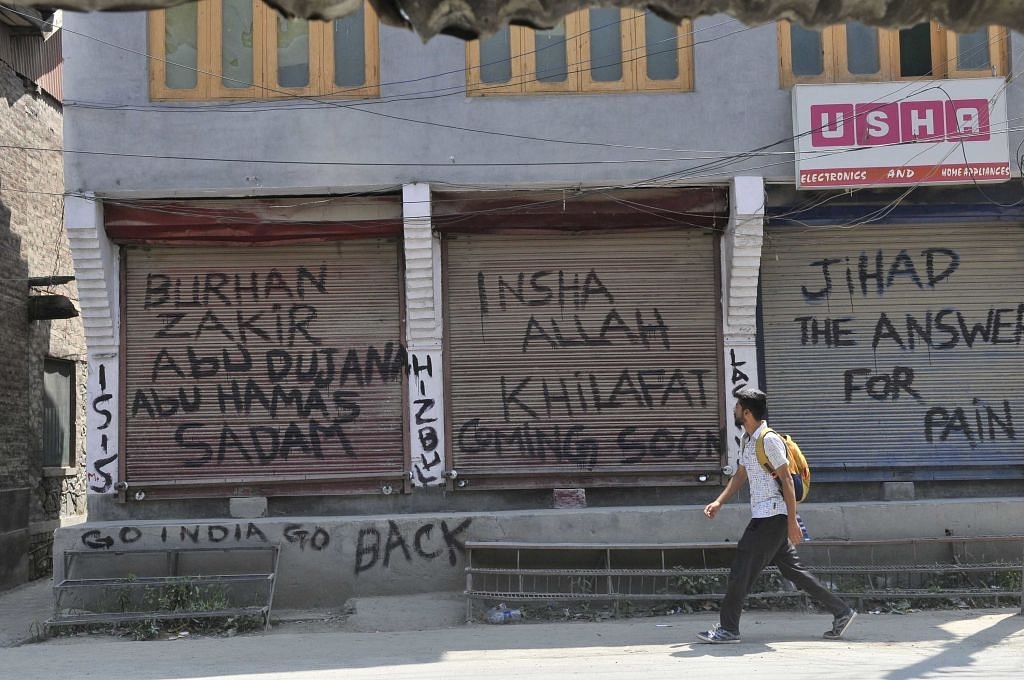Politics
A Year Post Burhan Wani’s Death, Big Change In Anti-Terror Fight In Kashmir
- The Indian Army, CRPF and Jammu and Kashmir police have stepped up the heat on militancy in Kashmir Valley in the one year since Burhan Wani’s death.

Terror slogans in Kashmir (Photo by Waseem Andrabi/Hindustan Times via Getty Images)
On 8 July 2016, Burhan Wani, Hizbul Mujahideen commander and militant poster boy, was killed in an encounter with security forces in Anantnag district of Jammu and Kashmir. Nearly a year later, on 27 May this year, security forces gunned down Wani’s second-in-command Sabzar Ahmad Bhat in Tral.
From Wani to Bhat, the landscape of politics, civil strife and militancy have undergone a sweeping change in the Kashmir valley over the year.
“Burhan Wani’s death shook the Hizbul thoroughly. They have not had another young leader like him who could sway the crowds so much. The Hizbul was like a fish out of water without him. So they try and instigate the youth against the state and army. They also lack money. So this attempt to snatch weapons and rob banks in separate incidents in Kupwara and Pulwama in June is a sign of desperation,” said a senior intelligence officer.
While the union home ministry has not beefed up security in the valley more than the existing scenario, the state government has suspended all internet services since Thursday to pre-empt the spread of hate through social media.
The days following Wani’s killing saw civil strife knife through Kashmir, with his funeral procession drawing unprecedented crowds. With the valley shutting down completely. Likewise, Bhat’s death too saw scores of people out on his funeral march, with no violent episodes of stone pelting being reported in the aftermath of his killing.
The Indian Army, the Central Reserve Police Force (CRPF) and the Jammu and Kashmir state police have stepped up the heat on militancy in the valley. Army General Bipin Rawat has criticised stone pelters for impeding security operations and supported Major Leetul Gogoi’s decision to use a Kashmiri human shield to keep stone-pelters at bay.
While security operations in the valley have been interrupted by stone-pelting mobs that break through the security cordon, Rawat said, “This is a proxy war and proxy war is a dirty war. It is played in a dirty way. The rules of engagements are there when the adversary comes face-to-face and fights with you.”
The centre has also been equally stern about its stance on Kashmir. Defence Minister Arun Jaitley, on 25 May sounded a clear warning, permitting the army to carry out operations in the valley as they deemed fit.
“They don’t have to consult Members of Parliament on what they should do under these circumstances,” Jaitley said.
Defence experts also asserted that the face of Kashmir had undergone a radical change since Burhan Wani’s killing last year.
With a decades-old military practice—the Cordon and Search Operation (CASO)—back in use, experts added that strategies too had undergone a sea change.
“This army does not take things like stone pelting lying down. Their stand is very clear. The borders have been sealed, and militants are being hunted down and killed. As for the Hizbul, they are crumbling under pressure from all quarters because the army is bringing back tactics from the 90s,” said Gaurav Arya, a defence expert and former army officer.
This article was originally published on Mint and has been republished here with permission.
Support Swarajya's 50 Ground Reports Project & Sponsor A Story
Every general election Swarajya does a 50 ground reports project.
Aimed only at serious readers and those who appreciate the nuances of political undercurrents, the project provides a sense of India's electoral landscape. As you know, these reports are produced after considerable investment of travel, time and effort on the ground.
This time too we've kicked off the project in style and have covered over 30 constituencies already. If you're someone who appreciates such work and have enjoyed our coverage please consider sponsoring a ground report for just Rs 2999 to Rs 19,999 - it goes a long way in helping us produce more quality reportage.
You can also back this project by becoming a subscriber for as little as Rs 999 - so do click on this links and choose a plan that suits you and back us.
Click below to contribute.
Latest